Abstract
The use of perhexiline maleate as an antianginal agent is occasionally associated with side effects, particularly neuropathy and liver damage. The reason why some individuals develop these toxic reactions is not clear, though some evidence suggests that they may result from impaired oxidative metabolism, due to genetic or hepatic factors, and consequential accumulation of the drug in toxic concentrations. Drug oxidation was measured with an oxidation phenotyping procedure in 34 patients treated with perhexiline, 20 of whom had developed neuropathy and 14 of whom had not. Most of the 20 patients with neuropathy, but not the unaffected patients, showed an impaired ability to effect metabolic drug oxidation. This impairment was independent of hepatic function, concurrent drug therapy, or tobacco or alcohol consumption. The fact that the ability to oxidise several drugs is genetically controlled points to a genetic susceptibility to developing neuropathy in response to perhexiline. Routine determination of the drug oxidation phenotype might lead to safer use of perhexiline by predicting patients who may be more at risk of developing a neuropathic reaction associated with its long-term use.
Full text
PDF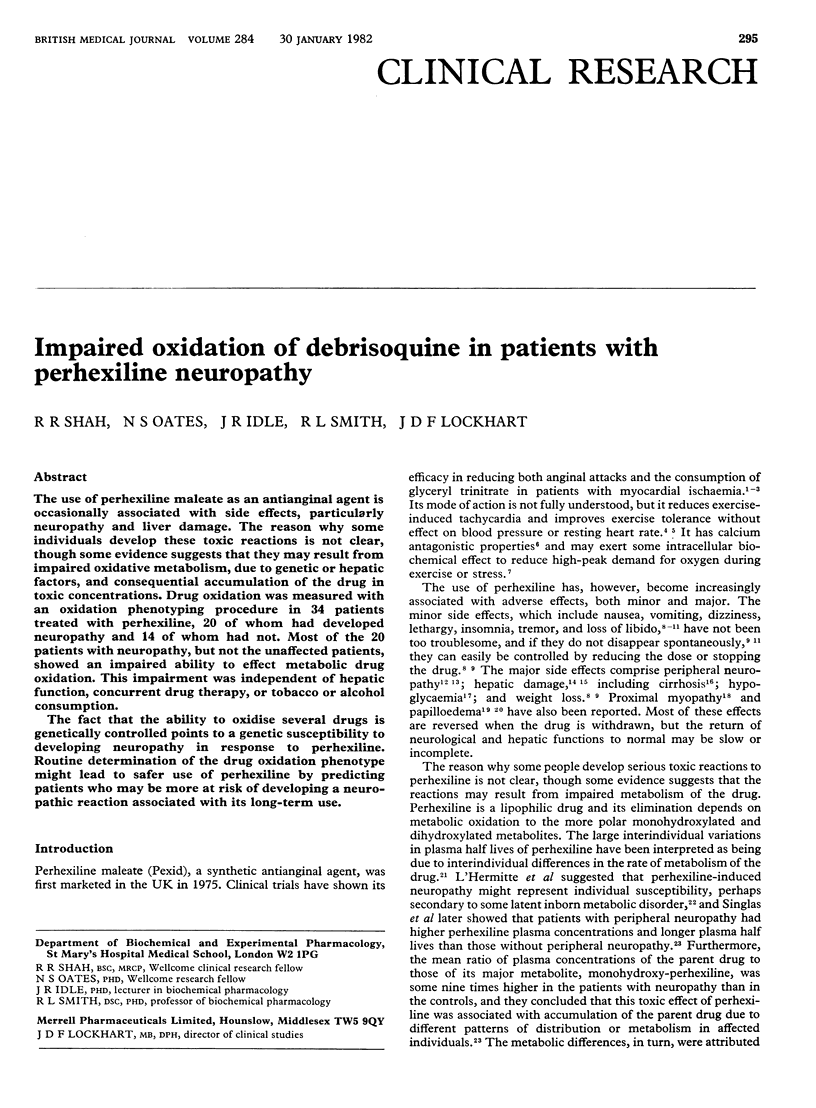
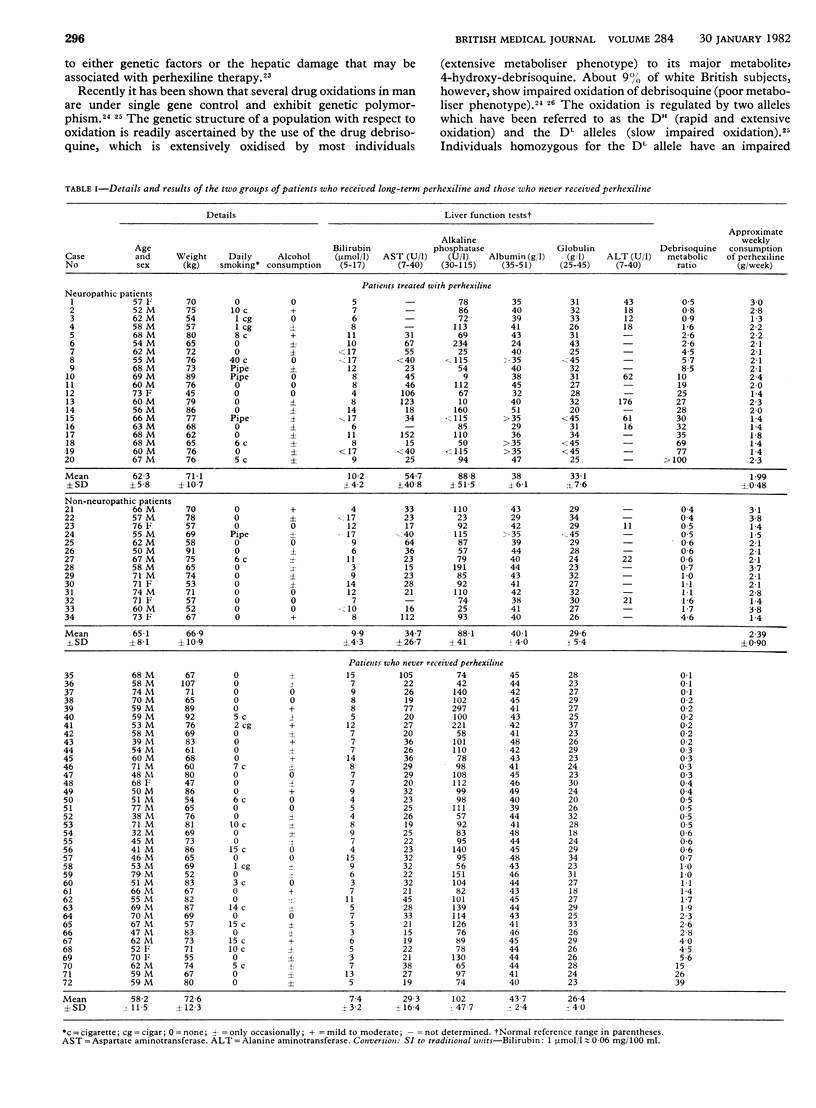
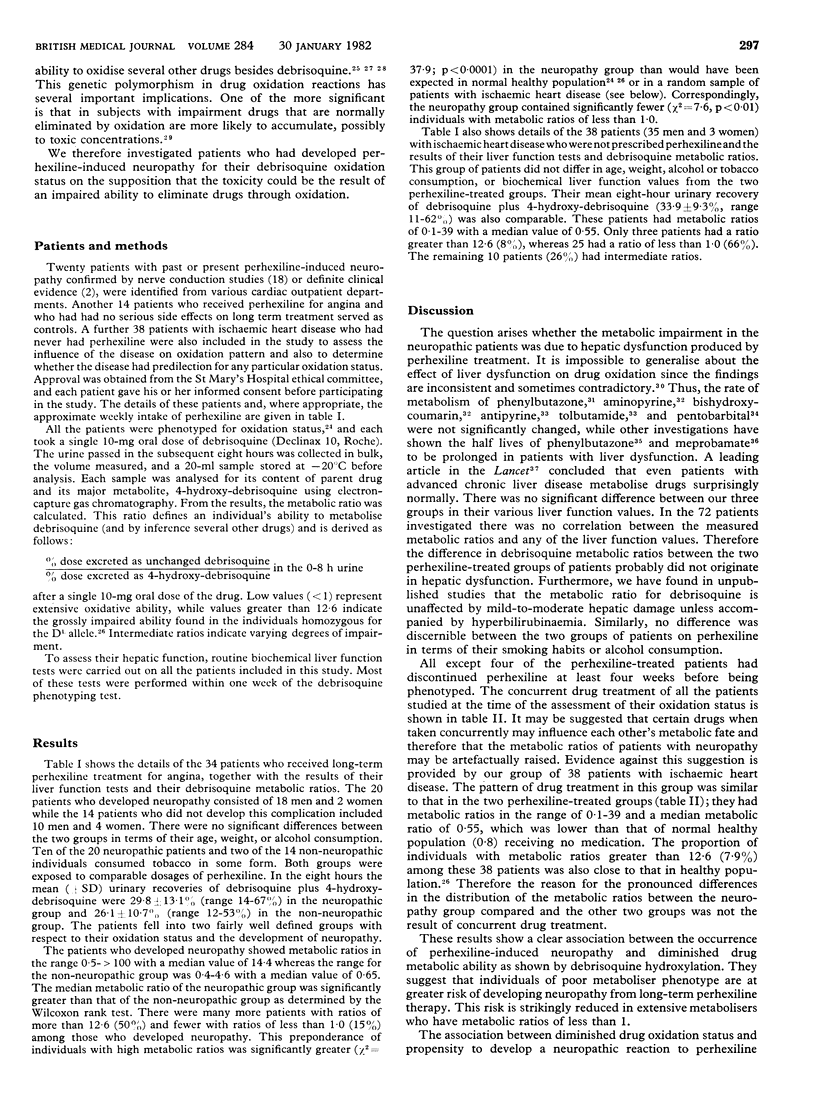
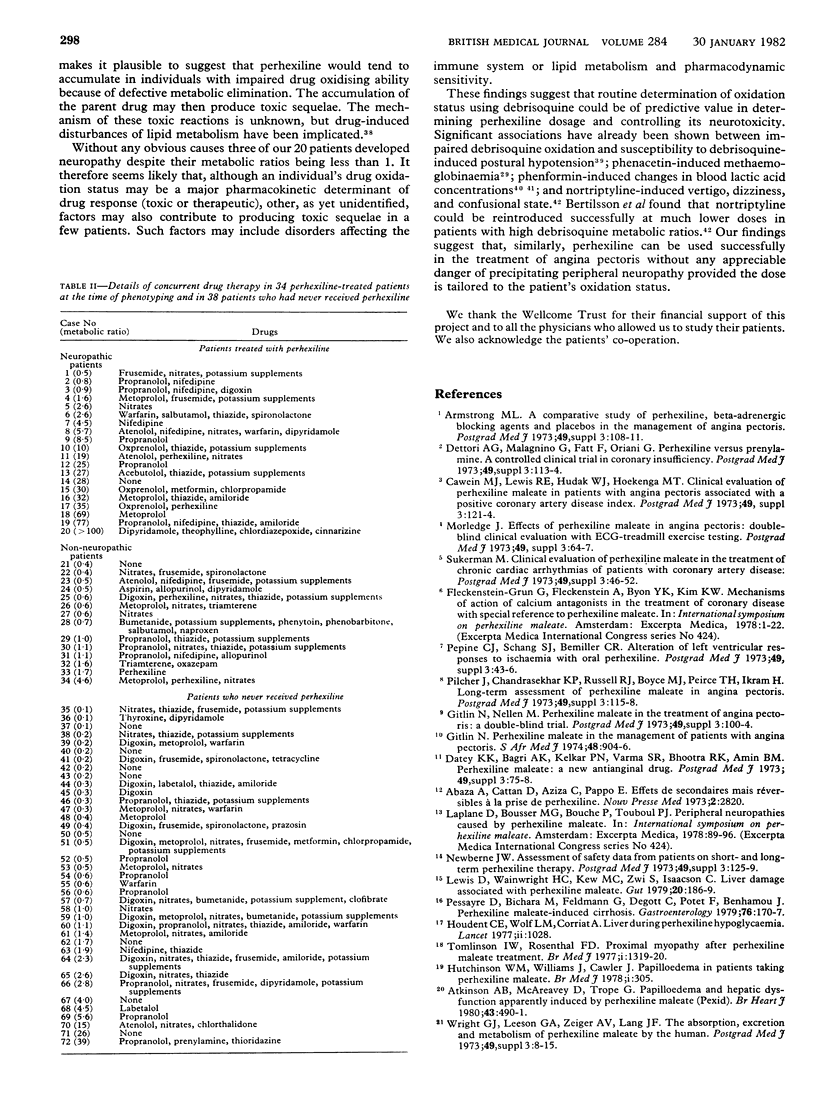
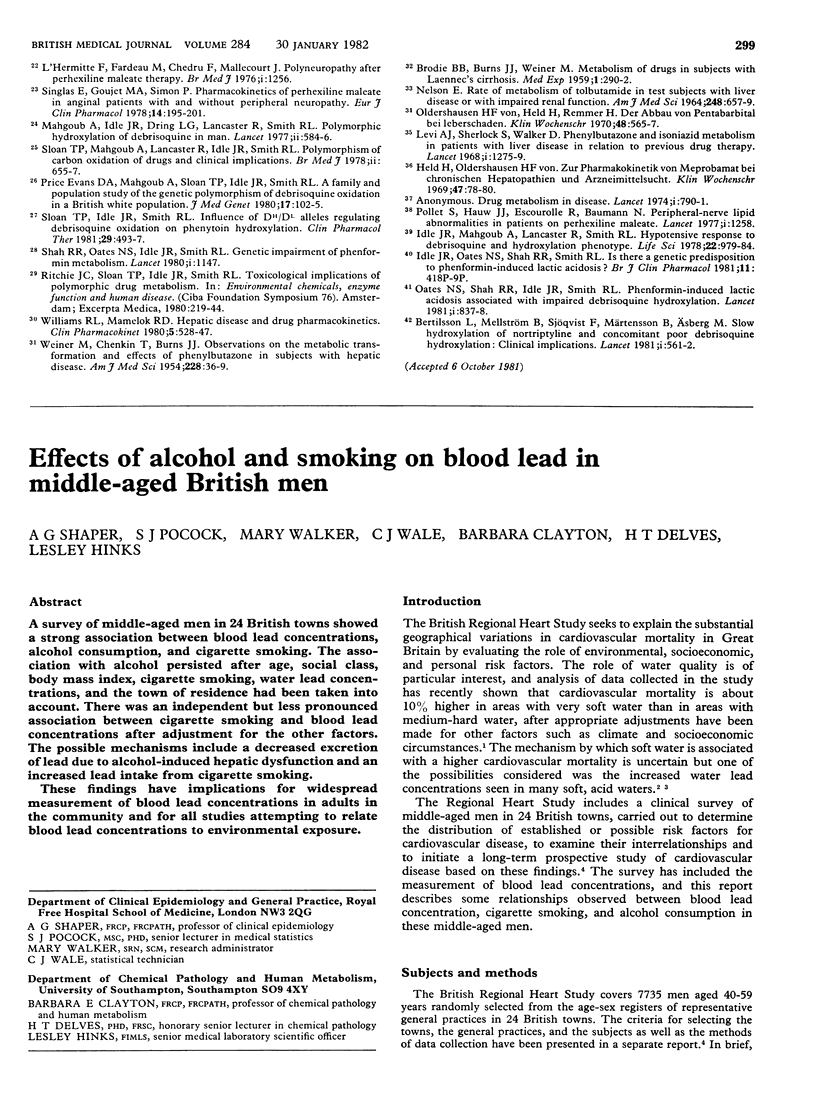
Selected References
These references are in PubMed. This may not be the complete list of references from this article.
- Abaza A., Cattan D., Aziza C., Pappo E. Lettre: Effets secondaires mais réversibles á la prise de perhexiline. Nouv Presse Med. 1973 Nov 24;2(42):2820–2820. [PubMed] [Google Scholar]
- Atkinson A. B., McAreavey D., Trope G. Papilloedema and hepatic dysfunction apparently induced by perhexiline maleate (Pexid). Br Heart J. 1980 Apr;43(4):490–491. doi: 10.1136/hrt.43.4.490. [DOI] [PMC free article] [PubMed] [Google Scholar]
- BRODIE B. B., BURNS J. J., WEINER M. Metabolism of drugs in subjects with Laennec's cirrhosis. Med Exp Int J Exp Med. 1959;1:290–292. doi: 10.1159/000134806. [DOI] [PubMed] [Google Scholar]
- Bertilsson L., Mellström B., Sjökvist F., Mårtenson B., Asberg M. Slow hydroxylation of nortriptyline and concomitant poor debrisoquine hydroxylation: clinical implications. Lancet. 1981 Mar 7;1(8219):560–561. doi: 10.1016/s0140-6736(81)92894-4. [DOI] [PubMed] [Google Scholar]
- Evans D. A., Mahgoub A., Sloan T. P., Idle J. R., Smith R. L. A family and population study of the genetic polymorphism of debrisoquine oxidation in a white British population. J Med Genet. 1980 Apr;17(2):102–105. doi: 10.1136/jmg.17.2.102. [DOI] [PMC free article] [PubMed] [Google Scholar]
- Gitlin N. Perhexiline maleate in the management of patients with angina pectoris. A long-term assessment. S Afr Med J. 1974 May 4;48(21):904–906. [PubMed] [Google Scholar]
- Held H., von Oldershausen H. F. Zur Pharmakokinetik von Meprobamat bei chronischen Hepatopathien und Arzneimittelsucht. Klin Wochenschr. 1969 Jan 15;47(2):78–80. doi: 10.1007/BF01745770. [DOI] [PubMed] [Google Scholar]
- Houdent C. E., Wolf L. M., Corriat A. Liver during perhexiline hypoglycaemia. Lancet. 1977 Nov 12;2(8046):1028–1028. doi: 10.1016/s0140-6736(77)92922-1. [DOI] [PubMed] [Google Scholar]
- Hutchinson W. M., Williams J., Gawler J. Papilloedema in patients taking perhexiline maleate. Br Med J. 1978 Feb 4;1(6108):305–305. doi: 10.1136/bmj.1.6108.305-a. [DOI] [PMC free article] [PubMed] [Google Scholar]
- Idle J. R., Mahgoub A., Lancaster R., Smith R. L. Hypotensive response to debrisoquine and hydroxylation phenotype. Life Sci. 1978 Mar;22(11):979–983. doi: 10.1016/0024-3205(78)90363-6. [DOI] [PubMed] [Google Scholar]
- Levi A. J., Sherlock S., Walker D. Phenylbutazone and isoniazid metabolism in patients with liver disease in relation to previous drug therapy. Lancet. 1968 Jun 15;1(7555):1275–1279. doi: 10.1016/s0140-6736(68)92292-7. [DOI] [PubMed] [Google Scholar]
- Lewis D., Wainwright H. C., Kew M. C., Zwi S., Isaacson C. Liver damage associated with perhexiline maleate. Gut. 1979 Mar;20(3):186–189. doi: 10.1136/gut.20.3.186. [DOI] [PMC free article] [PubMed] [Google Scholar]
- Lhermitte F., Fardeau M., Chedru F., Mallecourt J. Polyneuropathy after perhexiline maleate therapy. Br Med J. 1976 May 22;1(6020):1256–1256. doi: 10.1136/bmj.1.6020.1256. [DOI] [PMC free article] [PubMed] [Google Scholar]
- Mahgoub A., Idle J. R., Dring L. G., Lancaster R., Smith R. L. Polymorphic hydroxylation of Debrisoquine in man. Lancet. 1977 Sep 17;2(8038):584–586. doi: 10.1016/s0140-6736(77)91430-1. [DOI] [PubMed] [Google Scholar]
- NELSON E. RATE OF METABOLISM OF TOLBUTAMIDE IN TEST SUBJECTS WITH LIVER DISEASE OR WITH IMPAIRED RENAL FUNCTION. Am J Med Sci. 1964 Dec;248:657–659. doi: 10.1097/00000441-196412000-00004. [DOI] [PubMed] [Google Scholar]
- Oates N. S., Shah R. R., Idle J. R., Smith R. L. Phenformin-induced lacticacidosis associated with impaired debrisoquine hydroxylation. Lancet. 1981 Apr 11;1(8224):837–838. doi: 10.1016/s0140-6736(81)92711-2. [DOI] [PubMed] [Google Scholar]
- Pessayre D., Bichara M., Degott C., Potet F., Benhamou J. P., Feldmann G. Perhexiline maleate-induced cirrhosis. Gastroenterology. 1979 Jan;76(1):170–177. [PubMed] [Google Scholar]
- Pollet S., Hauw J. J., Escourolle R., Baumann N. Peripheral-nerve lipid abnormalities in patients on perhexiline maleate. Lancet. 1977 Jun 11;1(8024):1258–1258. doi: 10.1016/s0140-6736(77)92464-3. [DOI] [PubMed] [Google Scholar]
- Ritchie J. C., Sloan T. P., Idle J. R., Smith R. L. Toxicological implications of polymorphic drug metabolism. Ciba Found Symp. 1980;76:219–244. doi: 10.1002/9780470720592.ch12. [DOI] [PubMed] [Google Scholar]
- Shah R. R., Oates N. S., Idle J. R., Smith R. L. Genetic impairment of phenformin metabolism. Lancet. 1980 May 24;1(8178):1147–1147. doi: 10.1016/s0140-6736(80)91604-9. [DOI] [PubMed] [Google Scholar]
- Singlas E., Goujet M. A., Simon P. Pharmacokinetics of perhexiline maleate in anginal patients with and without peripheral neuropathy. Eur J Clin Pharmacol. 1978 Nov 27;14(3):195–201. doi: 10.1007/BF02089960. [DOI] [PubMed] [Google Scholar]
- Sloan T. P., Idle J. R., Smith R. L. Influence of DH/DL alleles regulating debrisoquine oxidation on phenytoin hydroxylation. Clin Pharmacol Ther. 1981 Apr;29(4):493–497. doi: 10.1038/clpt.1981.68. [DOI] [PubMed] [Google Scholar]
- Sloan T. P., Mahgoub A., Lancaster R., Idle J. R., Smith R. L. Polymorphism of carbon oxidation of drugs and clinical implications. Br Med J. 1978 Sep 2;2(6138):655–657. doi: 10.1136/bmj.2.6138.655. [DOI] [PMC free article] [PubMed] [Google Scholar]
- Sukerman M. Proceedings: Clinical evaluation of perhexiline maleate in the treatment of chronic cardiac arrhythmias of patients with coronary heart disease. Postgrad Med J. 1973 Apr;49(Suppl):46–52. [PubMed] [Google Scholar]
- Tomlinson I. W., Rosenthal F. D. Proximal myopathy after perhexiline maleate treatment. Br Med J. 1977 May 21;1(6072):1319–1320. doi: 10.1136/bmj.1.6072.1319. [DOI] [PMC free article] [PubMed] [Google Scholar]
- Williams R. L., Mamelok R. D. Hepatic disease and drug pharmacokinetics. Clin Pharmacokinet. 1980 Nov-Dec;5(6):528–547. doi: 10.2165/00003088-198005060-00002. [DOI] [PubMed] [Google Scholar]
- von Oldershausen H. F., Held H., Remmer H. Kurze wissenschaftliche Mitteilungen. Klin Wochenschr. 1970 May 1;48(9):565–567. doi: 10.1007/BF01488573. [DOI] [PubMed] [Google Scholar]


